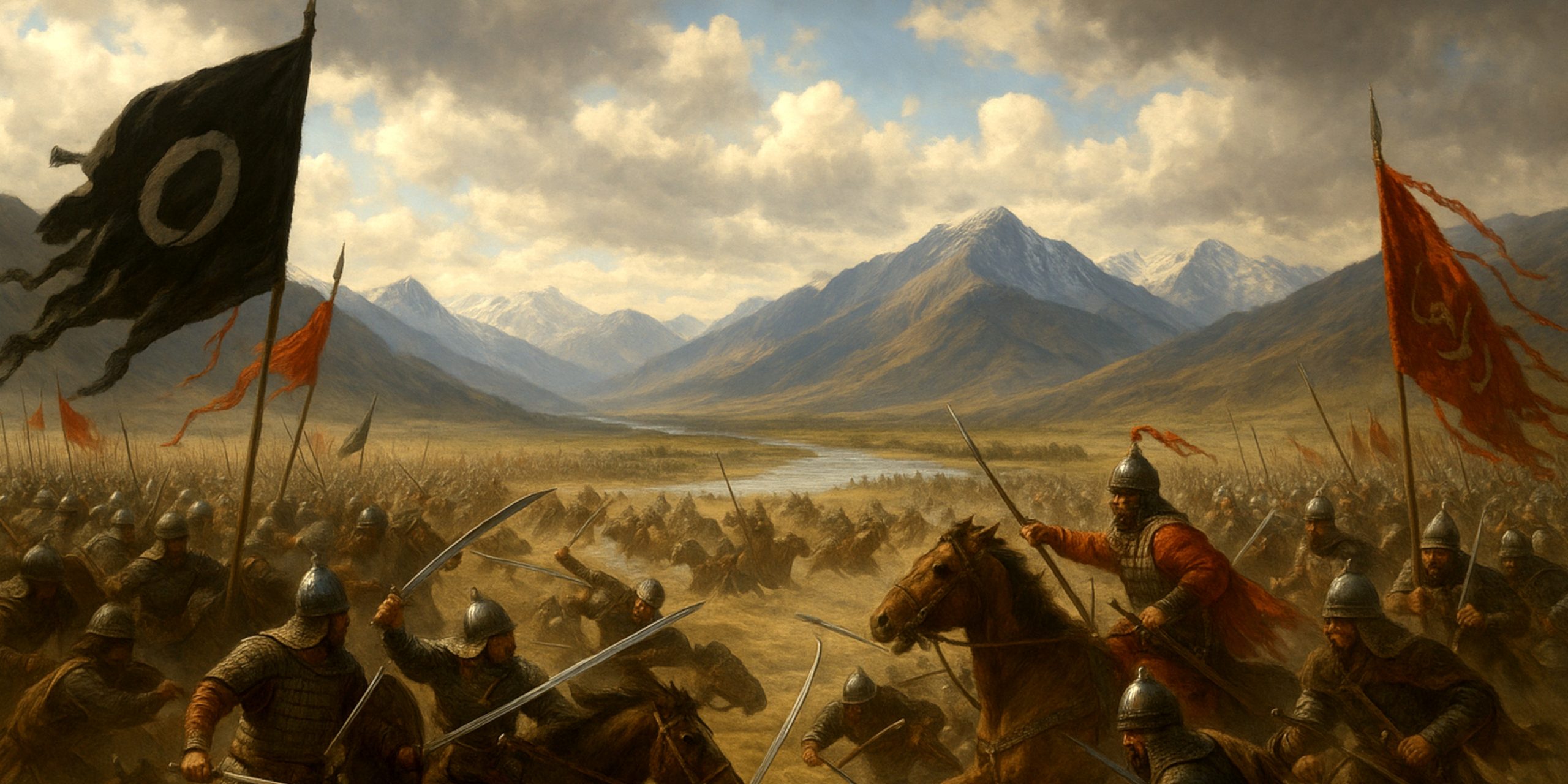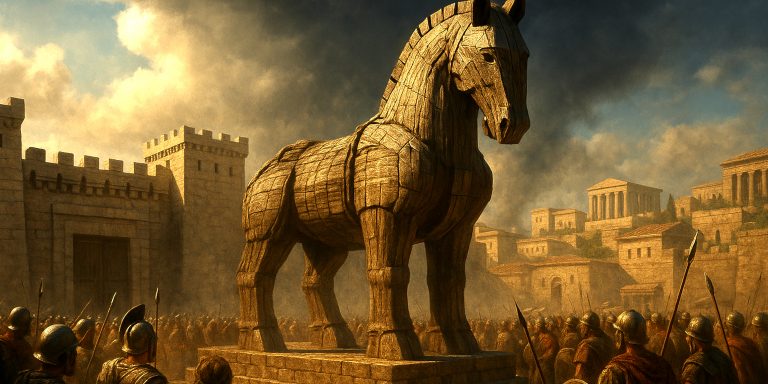
The Battle of Talas was one of those remarkable confrontations that altered the flow of civilisations without anyone fully realising it at the time. In 751 AD, on the dusty banks of the Talas River (in modern-day Kyrgyzstan or Kazakhstan, depending on which archaeologist you irritate), the forces of the Abbasid Caliphate met the Tang Dynasty of China. What ensued was a clash of the two greatest superpowers of the early medieval world.
It was not only a fight over territory and influence in Central Asia but a pivotal moment that determined whether the Silk Road would speak Arabic or Chinese. And though the battle itself is dimly recorded, its consequences, particularly the transfer of papermaking technology, echoed through every library and office printer that followed.
Background
The Tang Empire had expanded westward, asserting control over Central Asia’s oasis cities. Meanwhile, the Abbasid Caliphate, newly ascendant after toppling the Umayyads, pushed eastward. The frontier between the two was a ribbon of trade routes, tribes, and ambitions.
The flashpoint came when control of the small kingdom of Fergana was contested. The Tang supported one claimant; the Abbasids, another. Inevitably, the argument escalated from diplomacy to the kind of negotiation conducted by heavily armed men in very hot weather.
Forces
Abbasid Caliphate
| Commander | Abu Muslim’s lieutenant Ziyad ibn Salih |
|---|---|
| Estimated strength | 100,000 (Arab regulars, Persian auxiliaries, and allied Karluk Turks) |
| Composition | Infantry, cavalry (Arab and Persian), Karluk mercenaries |
Tang Dynasty
| Commander | General Gao Xianzhi |
|---|---|
| Estimated strength | 30,000 (Tang regulars and allied troops from Central Asian states) |
| Composition | Chinese infantry, cavalry from Ferghana and Sogdia, crossbowmen, and armoured spearmen |
Arms and Armour
The weaponry at Talas reflected two worlds of warfare colliding.
Tang Forces:
- Primary sword type: Dao (single-edged curved sabre) used by cavalry; Jian (double-edged straight sword) carried by officers.
- Armour: Lamellar iron or steel plates sewn to leather or silk backing.
- Missile weapons: Composite reflex bows and crossbows with deadly accuracy.
Abbasid Forces:
- Primary sword type: Saif (curved Arab sword derived from Persian influence) used by cavalry; Straight Khurasani blades among Persian units.
- Armour: Mail hauberks, scale armour, and light lamellar for horsemen.
- Missile weapons: Composite steppe bows, lances, and javelins.
This was the quintessential meeting of East and West in military technology. The Chinese fought in disciplined formations, while the Abbasids and their Karluk allies preferred flexible, mobile tactics. The Karluks’ sudden betrayal mid-battle, switching allegiance to the Arabs, was perhaps the most decisive act of opportunism since the Trojan Horse.
The Battle
The two armies met on the plain near the Talas River. For several days, both sides manoeuvred, testing each other with skirmishes and archery duels. The Tang general Gao Xianzhi initially held firm, relying on his disciplined troops and superior archers.
Then the Karluks, nominally allied to the Tang, turned their cloaks and struck the Chinese rear. Gao’s forces were encircled. Chaos followed, and despite his attempts to rally them, the Tang lines broke. The Abbasid cavalry surged in, sealing the victory.
Gao retreated eastward with a fraction of his men. The Tang never returned to Central Asia in strength.
Archaeology
Modern excavations near the Talas River valley have uncovered scattered graves, fragments of lamellar armour, and arrowheads consistent with both steppe and Chinese manufacture. There are also traces of camp structures believed to be from the Tang encampment.
Intriguingly, no large-scale battlefield monuments exist, perhaps a sign that both sides considered this a regional affair rather than a civilisation-defining moment. In hindsight, they were both wrong.
The most enduring archaeological legacy of Talas, however, is not physical remains but paper. Captured Chinese artisans reputedly introduced papermaking to the Islamic world, from where it spread westward, transforming record-keeping, scholarship, and bureaucracy.
Battle Timeline
| Year | Event |
|---|---|
| 749–750 | Abbasid Revolution topples the Umayyads; new caliphate rises with expansionist intent. |
| 751 (early) | Gao Xianzhi leads Tang forces west into Fergana to assert control. |
| Mid-751 | Ziyad ibn Salih gathers Arab and Persian forces near Samarkand; marches east to meet the Tang. |
| July 751 | The two armies engage near the Talas River. Karluk forces initially support the Tang. |
| Later in battle | Karluks betray the Tang, attacking their rear. Gao’s army collapses. |
| Aftermath | Tang retreat east; Abbasids solidify influence in Transoxiana. Chinese papermakers taken westward. |
Contemporary Quotes
- Arab chronicler Al-Yaqubi wrote: “The Chinese came with numbers and banners like a forest. Yet God granted victory to the believers.”
- Chinese sources, less triumphant, lamented: “The soldiers of the Middle Kingdom met men of the West who did not yield. Our banners were lost to treachery.”
- A Central Asian oral tradition summarised it bluntly: “When the mountains watched, the paper changed masters.”
Legacy
The immediate result of Talas was a shift in the balance of power along the Silk Road. The Abbasids gained prestige and access to Central Asian trade routes. The Tang, already strained by internal revolts, withdrew from the region entirely.
Far more important, however, was the cultural fallout. Papermaking spread west, eventually reaching Baghdad, Damascus, and then Europe. Without Talas, medieval scribes might still have been scraping vellum.
From a historian’s point of view, Talas is a reminder that history’s hinge moments often hide behind bureaucratic accidents and regional squabbles. A small battle on the steppe, forgotten for centuries, ended up being the quiet courier of literacy to the world.
The Seven Swords Takeaway
The Battle of Talas is one of those rare junctions where swords, politics, and stationery meet. Its outcome reshaped communication, bureaucracy, and trade, though few at the time grasped the enormity of what had happened.
For the Tang, it was the end of Central Asian ambition. For the Abbasids, it was a doorway into global influence. And for humanity, it was the moment parchment began to lose its monopoly.
Watch the documentary:



